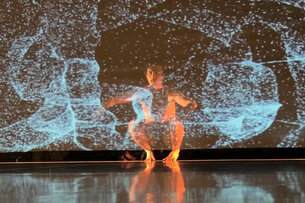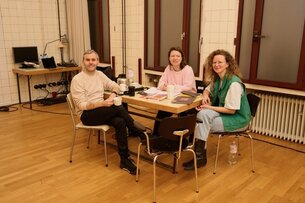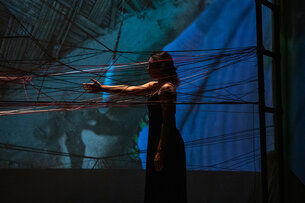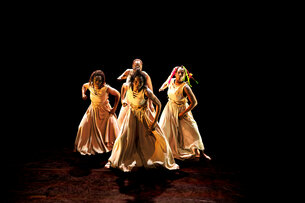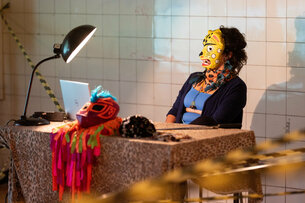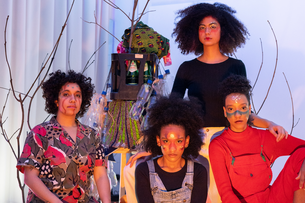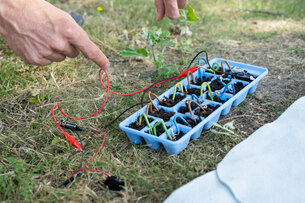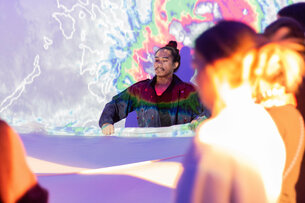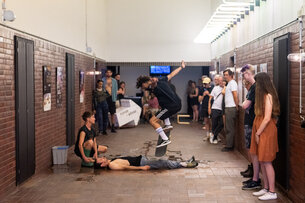#ResidencyInsights
Saša Asentić, Alexandre Achour, Jule Flierl, Rui Guo, Emily Hoffman and Olivera Kovačević Crnjanski
by
Fabio Neis
Themen
Residenzen
3 questions // Saša Asentić, Alexandre Achour, Jule Flierl, Rui Guo, Emily Hoffman and Olivera Kovačević Crnjanski
In your current research project you deal with the influence of the reunification of West and East Germany on the contemporary dance scene - what would you describe as characteristics of "eastern" dance? What was characteristic of the West German dance scene?
East German dance was characterized by a strong system of state theaters. Dancers would train in state academies and then be guaranteed positions in state companies, where they would dance for 15 years, after which they would receive a pension. In addition to the state theaters, there was widespread use of folk dance as a tool to build solidarity amongst citizens. Every university, factory, post office, etc. had a folk dance troupe. In the later years of the DDR there was also a small off-scene of dance and performance artists who organized performances in private spaces.
In our work, we try not to evaluate East in terms of West or to compare the aesthetics of East German dance and West German dance. Instead, we try to learn about the structures that supported dance in East Germany. We are used to seeing the socialist realism of East German art as a highly ideological form, and we are interested to look at West German dance as also a carrier of ideology and as the production of a certain kind of social body. The ideologies of course are different, but the processes are parallel.
After reunification, West German dance asserted itself as canonical. East German dance was largely dismissed, or interpreted only in relation to this Western dance history. Our interest is in imagining what could be another way for this reunification, rather than the total destruction and absorption of the socialist organization into the West German system. What might be retained from this socialist way of thinking or organizing? What has the wholesale rejection let go of that might inspire new ways to organize the freelance dance scene?
To what extent does the internationality of the participating artists have an impact on the content of your work?
We are a group of artists from former socialist countries (Yugoslavia, China, East Germany) and non-socialist countries (USA, France). We take East Germany as an example where the transition from socialism to capitalism happened in an extremely accelerated way, but we connect this transition to our experience in other post-socialist contexts. We don’t limit ourselves to these contexts, though, since the questions we are trying to raise about how the contemporary dance scene is organized are deeply relevant to those in western contexts as well. These are not marginal questions, but questions for all of us.
What does a typical rehearsal day at PACT look like during your residence time?
Every morning, one of the group presents a dance or body practice that they have experience with: American aerobics, fizkultura, contact improvisation, Chinese folk dance, Ausdruckstanz, etc. We then try to analyze what different social bodies these practices produce, what kinds of ideologies they carry. We discuss differences and similarities between the practices. Then we take lunch. Then we read and research about dance in the DDR and discuss both the specifics of what we have discovered in terms of artists, pieces, structures, and also larger social questions about how we are organized, how we are disciplined, what is taken for granted, and how we might organize differently.
Studio 3 at PACT Zollverein
Saša Asentić and his team examine the relations between the contemporary dance scene in West and East Germany since reunification from a critical standpoint and asks what remains of the GDR dance scene. Together with international artists* from Poland, Romania, Serbia, Croatia and China, Asentić reflects on the dance situation in post-socialist, transitory societies, with the aim of producing plural authenticities and facilitating an open and ongoing dialogue. The project wants to rediscover the dance of the GDR and bring out those choreographic concepts and practices that have lost themselves in the fog of history.
